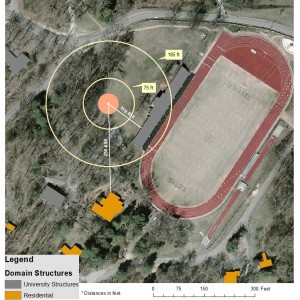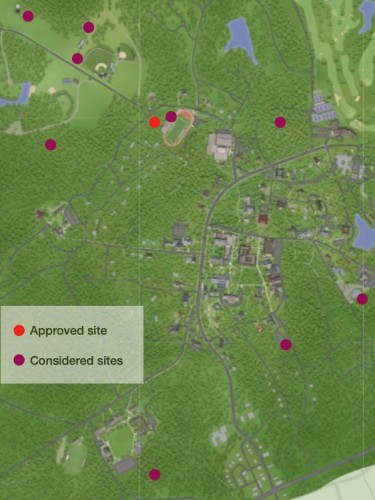The University will locate a new cell tower in the rear tailgate area of Sewanee’s Harris Stadium (football stadium). Here are FAQs about the project.
Where is the location?
 The location of the tower will be tucked away in the rear tailgate area of Sewanee’s Harris Stadium (football stadium). The location was selected in partnership with Verizon engineers to maximize coverage on campus and across the Domain and to address the needs of Franklin County emergency communications, and in consideration of environmental and FAA regulations. While there is no perfect location for a cell tower, a water tower, or a power line, wireless connectivity has become a basic utility that is needed for the safety and connectivity of the community.
The location of the tower will be tucked away in the rear tailgate area of Sewanee’s Harris Stadium (football stadium). The location was selected in partnership with Verizon engineers to maximize coverage on campus and across the Domain and to address the needs of Franklin County emergency communications, and in consideration of environmental and FAA regulations. While there is no perfect location for a cell tower, a water tower, or a power line, wireless connectivity has become a basic utility that is needed for the safety and connectivity of the community.
Why did the University return to the original location after looking at other options?
The coronavirus pandemic has created an urgency to address the inadequacy of cellular service on campus. The University must plan for the possibility that students and residents will be infected by the coronavirus. Any student or community member whose condition deteriorates into respiratory distress (or has any other emergency) needs to have reliable access to emergency support. The most expeditious path to a long-term cellular solution is to advance the previously approved cell tower.
When was the original plan approved?
In spring 2019, Franklin County Zoning Commission approved the University’s proposal to build a cellular tower on campus behind the football stadium.
Who is responsible for the tower?
The tower project is a collaboration led by the University, who will lease land to Vogue Towers for the construction of a monopole cell tower. The tower will be owned, insured, and maintained by Vogue, and Verizon will be the tower’s initial cell provider. The project will bring Verizon service to the community first; other cellular providers are expected to be added later. In addition, the new tower will improve emergency communications on the Domain and off the bluff.
What other sites have been considered? What are the relevant issues and constraints?
 The University has explored 11 locations. Each site was assessed initially to determine the tower height required to ensure effective propagation, and the height constraints due to the airport’s location and federal aviation requirements. Constructing a tower less than 200 feet tall removes the need for the tower to be lit and reduces the likelihood of FAA restrictions. The size of the campus and the stone construction of its buildings are additional constraints.
The University has explored 11 locations. Each site was assessed initially to determine the tower height required to ensure effective propagation, and the height constraints due to the airport’s location and federal aviation requirements. Constructing a tower less than 200 feet tall removes the need for the tower to be lit and reduces the likelihood of FAA restrictions. The size of the campus and the stone construction of its buildings are additional constraints.
Why does the tower need to be in the center of campus?
Providing effective cellular coverage on our campus requires a strong enough signal to penetrate the stone University buildings and still reach as much of the trail system across the Domain as possible. Given the rural area and small population, most cell providers will not invest in multiple solutions; the University will be best served by a single tower that is strategically located to maximize coverage across our vast campus. The central location also allows for a shorter tower.
What providers will be on the tower?
The tower will have capacity for three providers. Verizon has partnered with the University and Vogue through this process and Verizon will be the lead provider. Vogue anticipates adding additional providers after the tower is constructed.
What regulatory requirements and precautions are necessary to build a cellular tower?
Beyond a lease agreement with the University, cell towers in general require approval by the Franklin County Zoning Commission and must comply with the National Environmental Policy Act. Additionally, the State Historic Preservation Office (SHPO) reviews and must sign off on proposals.
What regulatory requirements remain before the University can proceed?
As of August 2020, the University expects to receive feedback from SHPO fairly soon; their feedback will influence the next steps in the University’s planning process.
What will the tower look and sound like?
The proposed tower will be 185 feet tall with a 50’x50’ fenced area. A wood privacy fence and evergreens will screen all equipment in the enclosure. The tower will not be lit. A small generator will come on during power outages; there will be no continuous noise from the tower.
(Header photo by Artem Beliaikin on Unsplash)

